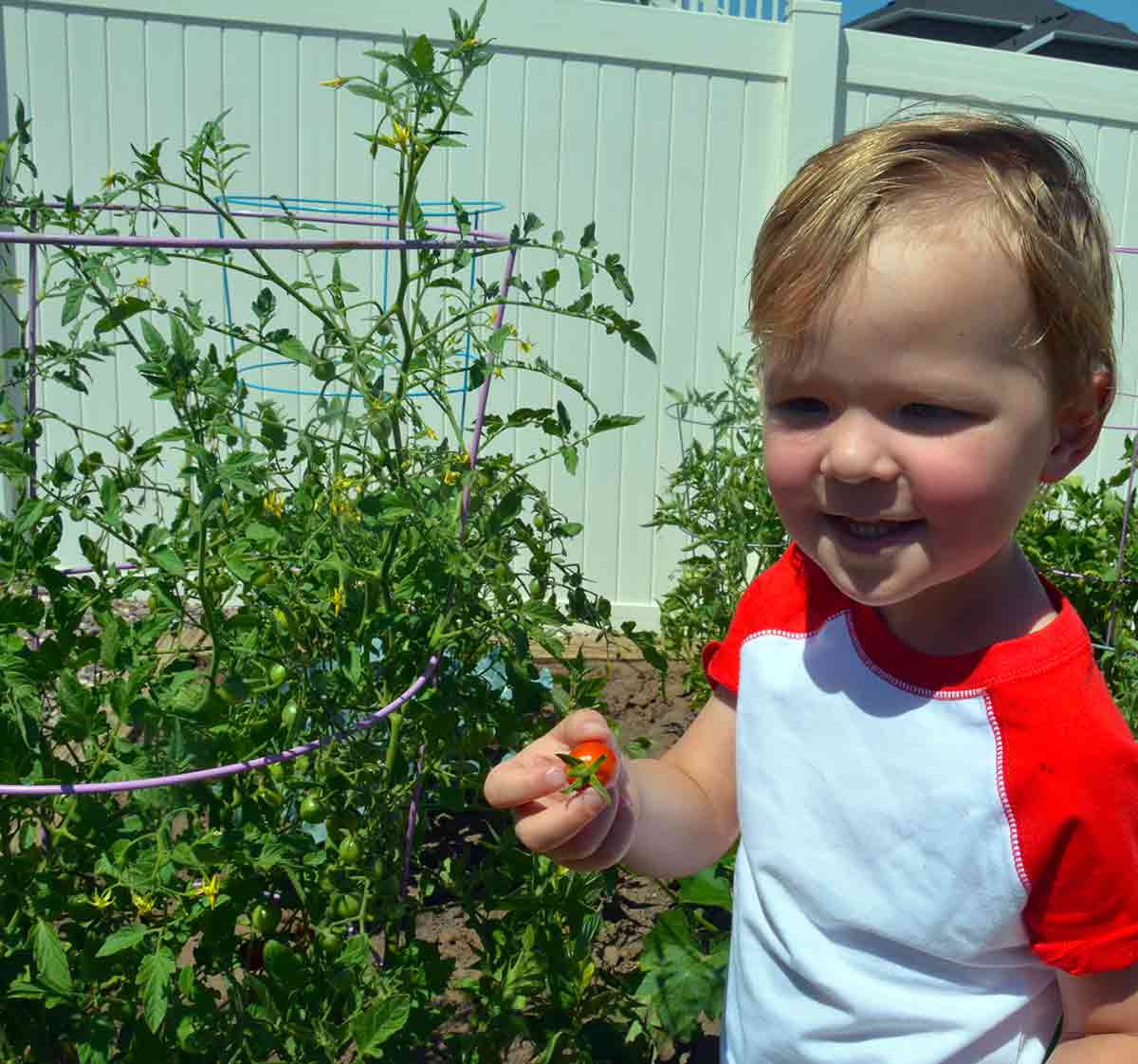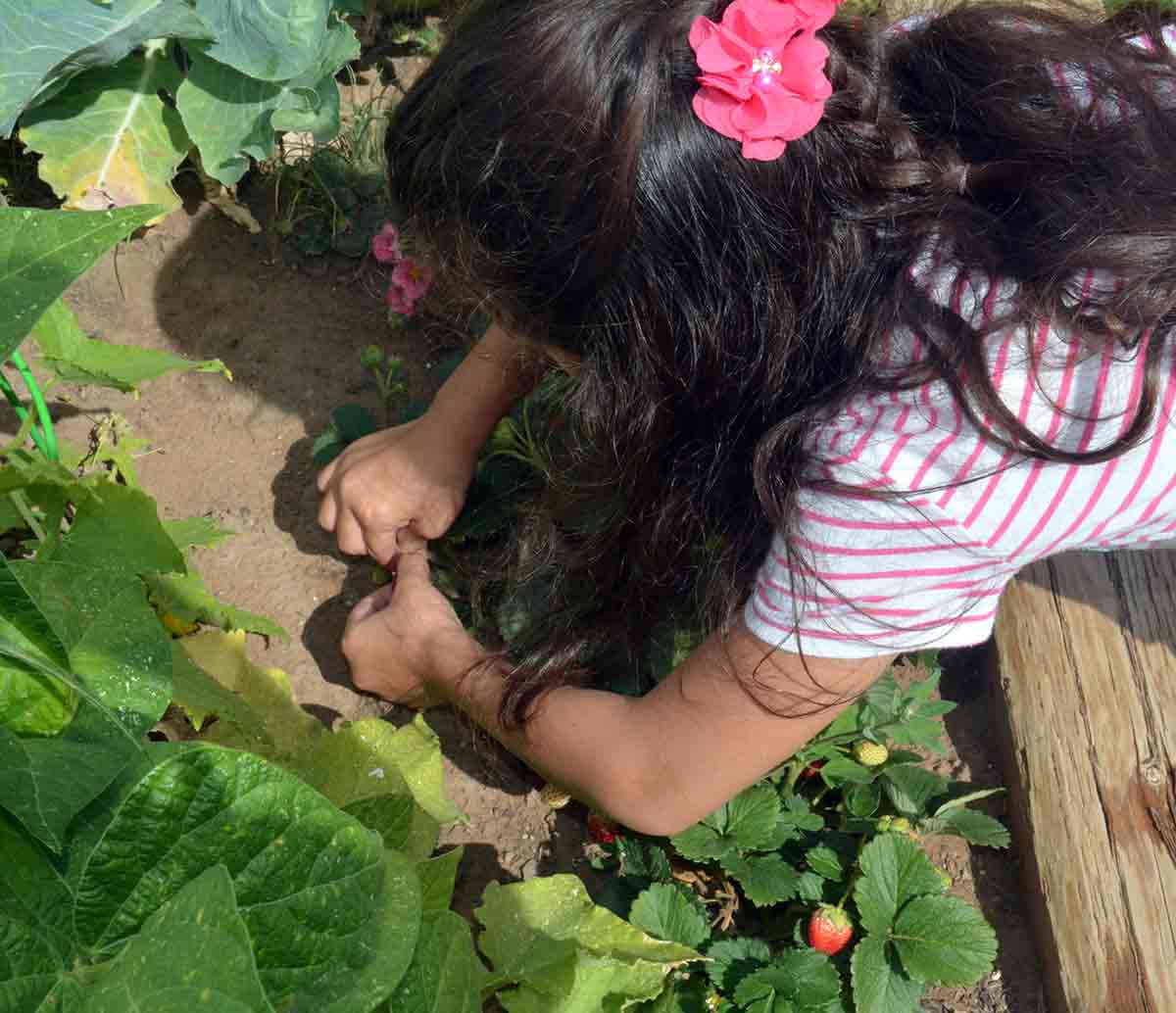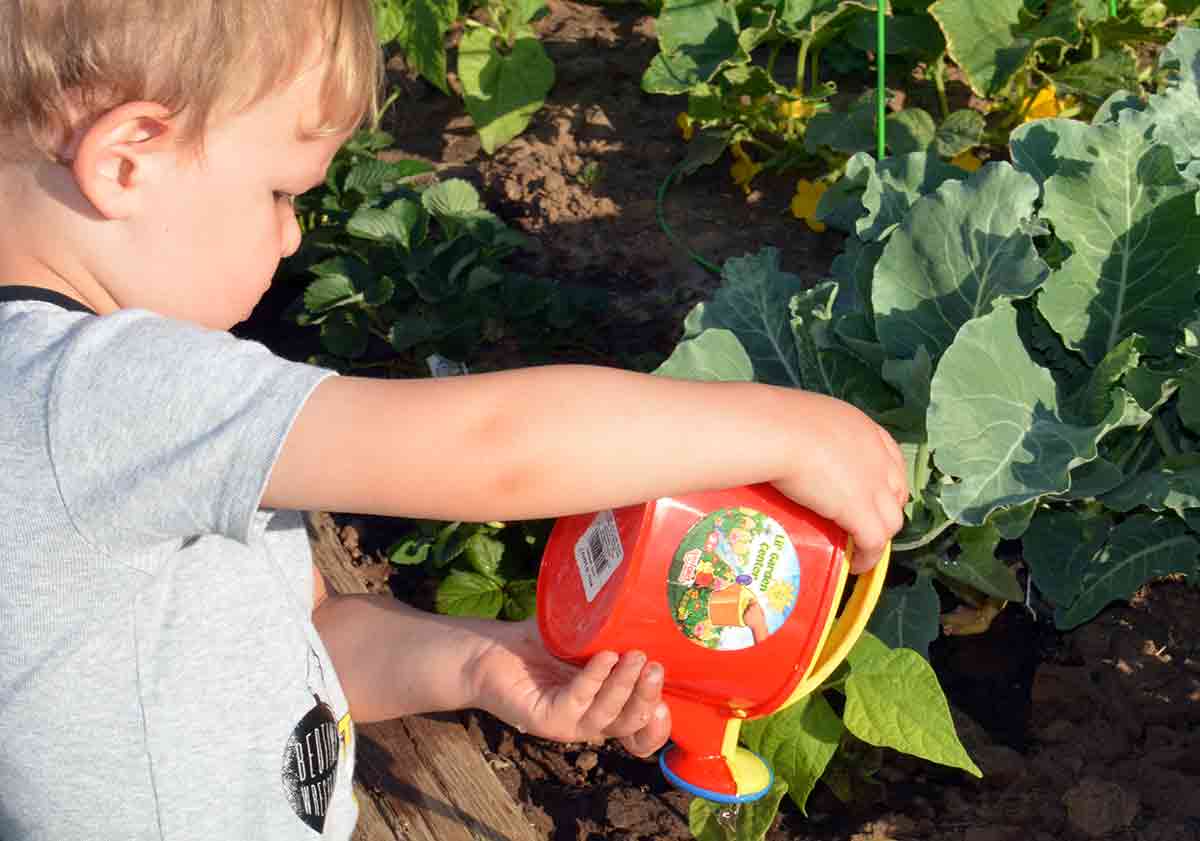Inside: Gardening with kids and grandkids is a powerful learning experience. They get to plant, water, weed, and watch things grow into something edible, delicious, and nutritious. It’s Spring! Plant a garden with your kids & grandkids! Make it a yearly family tradition and activity they will remember!
Gardening With Kids & Grandkids
Note: all of these pictures are of our grandkids helping us plant the garden!
It’s Spring and guess what? It’s time to plant a garden with your kids and grandkids!
When I was young, we planted vegetable gardens each year, but our family’s pride and joy (particularly my dad) was our amazing raspberry patch. It was huge! My siblings and I helped our dad with the planting and nurturing and picking the ripe berries each day. The downside: grasshoppers the size of elephants jumped around us as we tried to pick the berries and scared the wits out of us. When they landed on us, we ran out of the patch screaming and dropping our buckets of berries. Our dad was not amused…
Grasshoppers aside, the best part was putting loads of fresh ruby-red berries on our vanilla ice cream. We felt a certain pride knowing those raspberries were raised and nurtured by our family. Many fond memories were created around that raspberry patch.

Here are different things you will need to do when planting a garden. There are plenty of jobs that your children can participate in.
Gardening With Kids & Grandkids
Growing a garden is not only a fun experience for kids/grandkids—it’s memorable and educational, too. They learn many things when they’re up to their elbows in dirt.
Something magical happens when a child helps to plant, nourish, prune and harvest the family garden. They learn:
- Eating what they’ve grown
- Creating recipes that include fruits or veggies from their garden
- Sharing with others the family’s garden bounty
- Canning or freezing some of the fruits and veggies for future eating
10 Tips for Gardening With Kids/Grandkids
Here are some tips and steps to help your family create the most amazing garden ever!
Tip #1: Hold a Family Council to Discuss the Garden
Before planting your garden, hold a family council. Get input from your kids/grandkids on what kinds of vegetables and/or fruits they want to grow and eat.
Together, discuss the following:
#1: Determine the size of your garden plot so you can decide how many fruits and veggies you can grow in the space. Choose a variety of vegetables to plant.
#2: Make certain the weather in your area is good for growing the fruits and veggies you want to plant.
#3: Plant fruit trees that are adaptable for your area. We planted lemon, orange, apricot, plum, and peach trees.
#4: Have your kids choose a berry to plant so they can experience fruit growing on a vine such as raspberries, blackberries, or boysenberries.
#5: Be prepared for something not to grow. Learning by trial and error is a great teacher but I would suggest that after you choose what plants to grow—go to the library; check out some gardening books and find out everything you can about the particular fruit or vegetable you want to grow.
#6: And grow foods your family will eat.

Notice the lemon trees–those trees produced enough lemons for our family and the entire neighborhood.
Tip #2: Going to the Nursery: Buying Seeds, Plants, Soil & Fertilizers
Go to your local nursery or Farmer’s Market and look for heirloom seeds and plant “starts.”
Heirloom seeds are seeds from real fruits and veggies. Once you grow your fruits and veggies, you can carefully extract some of the seeds, and save them for your garden the following year. This is what farmers do—save seeds from one season to the next. It’s a money-saver and if it’s a seed from a prize-winning tomato—you want to have that same seed to plant again.
Other kinds of seeds are called genetically modified seeds (GMO) or what I like to call “fake” seeds because they have been manufactured in a lab. Steer clear of GMO seeds—they are asexual meaning the seeds will not reproduce so they can’t be saved.
The fruit and veggies produced from GMO seeds taste bland and are devoid of important vitamins and minerals.
Plant “Starts”
Plant starts are seeds that have been planted in soil, have sprouted, and are growing. They come in a variety of sizes from 2-10-inch pots. The advantage: it gives your fruit or veggie a head-start.
We’ve planted both heirloom seeds and plant “starts.”
Purchasing Soil, Fertilizers & Trellis
First, have your soil tested. Most universities and colleges offer this service and it costs about $30. The test will show if your soil needs a particular nutrient that needs to be added. It’s important if you want healthy veggies.
Purchase some soil to mix into the soil you already have. I prefer organic soil because it’s free of pesticides, herbicides, etc. And purchase organic fertilizer or mulch. Last, if you’re growing tomatoes or beans purchase a trellis.
Tip #3: Prepare the Soil & Plant the Seeds
No matter where you live, your garden will need a yearly spring cleaning. Get the whole family involved. It can be dirty work, but kids love getting dirty!
Spring cleaning the garden includes raking away any debris or dead leaves and amending the soil. Soil amendment means you are adding physical or chemical materials (fertilizer or mulch) to the soil to improve permeability and water retention. It’s also a time to add organic soil and till the whole area. Carefully preparing the soil with rich nutrients means your plants will be healthy and strong.
Afterward, the kids can plant the seeds in rows; make signs with the names of the particular veggie or fruit and stick them in the ground where they’ve planted the seeds.
When planting your seeds, put them in the right location. Some plants need part sun and part shade, while others thrive best in direct sunlight.
And don’t forget the snail bait! Otherwise, the snails will eat up your garden.
Tip #4: Weeding the Garden
The next step is weeding.
Weeds are a part of life—but it’s important to weed your garden so they don’t choke out the healthy plants. There are two aspects of weeding to explain to your kids/grandkids: eradication and prevention.
Eradication means pulling out or getting rid of any weeds in your garden. The tricky part is they grow very close to your plant and sometimes they have flowers on them so they look harmless. They aren’t—given a chance they’ll choke the life out of your plant.
Preventing weeds from growing is only partly possible. To slow down the growth of weeds we put down weed cloth. It works great and cuts down the number of weeds we have to pull.
Tip #5: How Things Grow: Water, Sunlight & Healthy Soil
Children will grasp the concept that in order for plants to grow and survive, they need three things: sunlight, water, and healthy soil.
Giving the right amount of water to your plants is important. You don’t want to drown the plants or not give them enough water. Both kill plants. Water your plants, then wait until the soil is completely dry before watering again. But sometimes that doesn’t work. Watch the leaves of the fruit or vegetable—are they wilting? If so, water them.
Make a chart showing the days the plants need water. Then check the leaves of the plant and the soil.
Sometimes your fruit trees will need vitamins. We had lemon and orange trees and every other year we had the local nursery inject the trees with vitamins. This helped to improve the flavor, size, and health of the fruits.
Tip #6: What to do with all those Fruits & Veggies
Practice sleuthing as a family and find some recipes you can make with all your fruits and veggies. Eating fruits and vegetables fresh and raw is always the best, but it’s also important for kids/grandkids to learn to read a recipe and use what they’ve grown in a recipe.
Some of our family’s favorite recipes from our yearly garden harvest and fruit trees include:
- zucchini relish
- marinated carrots
- crockpot apple butter
- healthy summer salad,
- marinated green beans
- refrigerator pickles
- berry and peach cobbler
- lemonade
- strawberry ice cream
- lemon, orange & banana ice cream
Think about canning or freezing different fruits and vegetables. Freezer jams and jellies are easy and do not require any cooking. There are canning recipes for fruits and veggies that you put in jars and immerse in a hot water bath on the stove. The advantage is that the food will keep for several months.
This section is to give you ideas to teach your children about the “philosophical” aspects of gardening. Gardens are amazing for creating metaphors for learning. Here are some tips to incorporate when teaching your children about the “garden of life…”
Tip #7: Planting Seeds Every Day

Kids feel a sense of pride and accomplishment when they help in the garden. It builds their self-esteem to see something that they planted grow into a vegetable or fruit.
Share with your children/grandchildren about seeds that can be “grown” every day. In our family, we called them “character seeds,” because they included such things as spreading kindness, generosity, compassion, helpfulness, etc., to others.
It’s a well-known fact that we live in a busy, hectic world, and it’s just getting busier. But, helping your children to set aside time for growing character seeds influences not only the people they show kindness to, but it’s reflected in their personality and character as well.
Planting character seeds don’t cost anything and the time it takes to extend kindness, etc., to others is small and always comes back 10-fold.
Tip #8: The Beauty of Diversity
No one plants just zucchini in their vegetable garden or just lilacs in their flower garden. It would be boring, monotonous, and stagnating. Just as kids love to plant a variety of fruits and vegetables in their gardens, diversity, and a variety of people are what make life interesting.
Why? Because everyone brings to this earth their talents, strengths, and creativity to make this world a more fascinating place.
One thing I loved about raising our kids in Southern California was the immense diversity of people—ethnic diversity, skin color, race, and religion. It was an amazing melting pot of talent and our family felt blessed to be in that atmosphere.
Just like a garden would be dull and boring with only one kind of vegetable; it’s the differences of people in the world that create a magnificent garden of beauty.
Tip #9: Pruning: A Necessity
Ask anyone who prunes and they’ll tell you it’s “a science.” You need to know when, how, where and how much to prune the plants in your garden. Pruning helps a plant reach its potential. Done correctly, it helps the plant create bigger and better fruit, flowers, and veggies.
Pruning is necessary when raising children. Kids need their parents to guide and correct them and to help “trim” branches of their personalities that are getting in the way of their growth. With careful pruning geared to the personality of each child, parents can help their children blossom and grow into something spectacular!
Tip #10: Law of the Harvest
Everyone knows the law of the harvest—you reap what you sow. However, I don’t believe that’s what always happens in life…or in the garden.
Each year our family carefully planted fruits and vegetables in the locations where they would grow best. We watered and weeded but sometimes the plants refused to grow or they started to grow and then stopped. When it was our fault, we made course corrections, but sometimes—it was mother nature’s fault. She didn’t provide enough hot sunlight and when that happened certain veggies didn’t grow—like tomatoes.
The same can be said about raising kids. Like growing plants, parents can nurture, water, and “weed” their children; giving them the best opportunities for growth. But it doesn’t always mean children will rise up, grow and meet their potential.
In times like this, the best thing to do is be patient. Letting your child find their own way and blossom in their own time just may be the answer to their growth. Either way—never give up on them! Eventually, kids with parents who love and nurture them, become amazing adults (and even tomatoes grow into healthy, hearty plants).
“Get to Know Your Ancestor’s” Tip
Research your family tree and discover ancestors who loved gardening (most of them did). When planting your garden, show pictures of their ancestors and what they planted to your kids/grandkids. Include 3-4 different veggies in your garden that your ancestors planted. It’s a special way of connecting your children/grandchildren to their ancestors and appreciating that their talents and similarities are similar to ours.
Have you grown a garden with your kids? What have been your experiences? We would love to know! Please comment in the section below.
Want to remember this post? Post, “How to Garden With Kids: 10 Simple and Amazing Steps” to your favorite Pinterest Board!
FAQ’s
What can I plant with kids?
You can plant vegetables, fruits, or flowers with kids. The location of your garden is important. Do some basic research into what fruits, vegetables, and flowers will work best in your state or country and your yard area. Suggestions: tomatoes (need lots of sunlight), zucchini (one plant seems to produce 100s of this prolific veggie), carrots (not as easy to grow as you might think), sweet peppers, broccoli, and cucumbers (fairly easy to grow).
How does gardening help a child’s development?
Planting a garden with your children is one of those activities where multiple lessons and development happen. Children need to move and they need to be involved in creative play to learn and grow. Planting a garden provides both of these activities and more. Plus, planting a garden can also teach children values such as Character Seeds: include spreading kindness to others, being generous, helpful and compassionate to others The Beauty of Diversity: Just as kids love to plant a variety of fruits and veggies in their gardens, diversity, and varieties of people is what makes the world a colorful and interesting place. Pruning: just like it’s necessary to prune your fruit trees, pruning is necessary when raising kids. Kids need parents to guide and correct them and help them to “trim” their branches of personalities that are getting in the way of their growth and potential.
What can I plant in a Kid’s Garden?
Are you planting veggies, fruits, or flowers? If it’s a vegetable garden and you live in a climate that has lots of hot sun during the summer here are some suggestions: Tomatoes—thrive on hot sunny days Zucchini—this is an easy and very prolific veggie Broccoli—fairly easy to grow and your kids will learn that they are actually eating the flower of this plant Cucumbers—easy to grow; they need a lot of sun Carrots—they grow underground and not as easy as you think to grow Herb gardens—thyme, basil, rosemary. If you have a child or teens that love to cook and add fun herbs—get them involved in growing an herb garden.

















Gardening is an excellent activity, which not only helps children learn about plants & environmental science but also helps them nurture skills like patience, responsibility, caring and affection for nature. Here are some helpful tips by me to transform their entire gardening experience into a well-planned adventure. https://kidpillar.com/gardening-for-kids/
Thank you for your ideas and comments! Yes, I agree–gardening is such an amazing tool for teaching kids (and grandkids) so many important lessons and values. I’ll check out your link!
First of all, your grandchildren are adorable!! Secondly, I love your childhood story of planting raspberry patches with your dad and siblings. What great memories you have even if they all seemed to end in terror over grasshoppers 😉 I keep saying I want to plant a garden every spring but I struggle so much with maintaining it. I really need to get my son outside with me to do it and have him help with the maintenance…and the manual labor too. Thanks for the tips and wonderful infographic too!
Yes, I know all about maintaining a garden–lots of work! But, it has given our family a deeper appreciation and respect for farmers. I’ve come to believe they are some of the hardest workers around. Spending a lot of time maintaining a garden and then having something not grow or die was frustrating, but usually things grew and the kids were excited. Yes, get Zach to help–and you are such an amazing cook you can use a lot of the things you grow in your recipes!